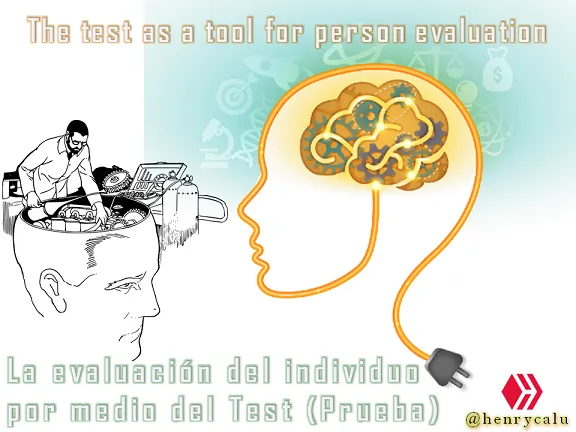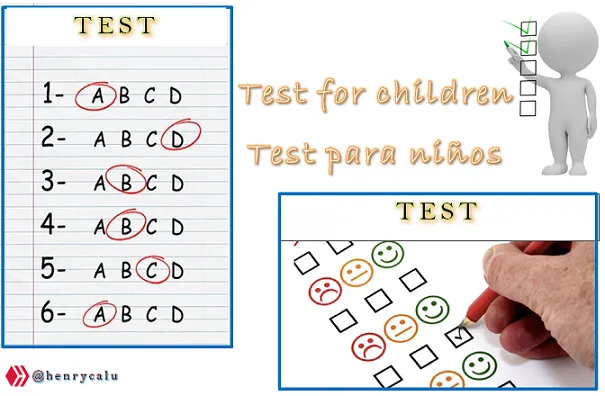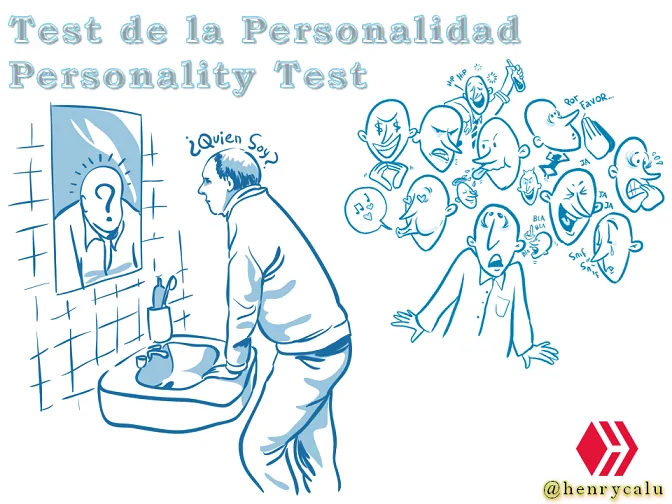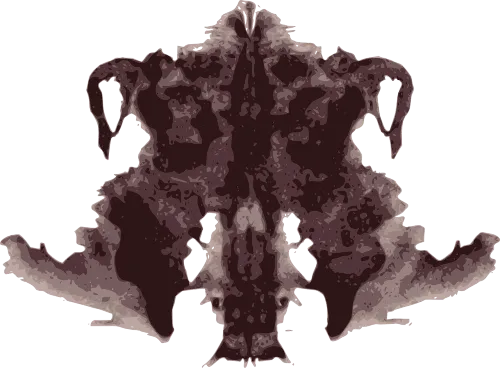
When looking for the definition of the procedure used to evaluate a certain degree of intelligence, special aptitudes (sensorial, motor, artistic...), in addition to the aspects of character and personality of a certain individual. ), in addition to the aspects of the character and personality of a certain individual; all this, together with the capacity that the human being possesses to attend and solve situations, which in a certain way are complicated for some but not for others; where their attitudes and possible behaviors are also measured, just by answering a simple list of questions made as a survey, which are answered briefly by pointing out only one among several options presented, that according to the criteria, culture and values handled by the individual who is surveyed or examined, you can determine their psychic capacity, that is, the development of their mental level; it is concluded that this procedure is called with the English word "Test", which means "Test" in Psychology.
Al buscar la definición del procedimiento que se usa para evaluar cierto grado de inteligencia, aptitudes especiales (sensoriales, motoras, artísticas…), además de los aspectos del carácter y la personalidad de un determinado individuo; todo ello, aunado a la capacidad que posee el ser humano para atender y resolver situaciones, que de cierta manera son complicadas para algunos pero para otros no; en donde también son medidas sus actitudes y posibles conductas, tan sólo por responder un listado sencillo de preguntas realizadas a manera de encuesta, las cuales se contestan brevemente al señalar una sola entre varias opciones presentadas, que de acuerdo al criterio, cultura y valores manejado por el individuo que es encuestado o examinado, se puede determinar su capacidad psíquica, es decir, el desarrollo de su nivel mental; se llega a la conclusión que dicho procedimiento se le denomina con la palabra inglesa “Test”, lo cual significa “Prueba” en Psicología.

According to this far-fetched definition, tests can be classified into: age or mental development tests, aptitude tests and personality tests.
De acuerdo con esta rebuscada definición, los test pueden clasificarse en: test de edad o desarrollo mental, test de aptitudes y test de personalidad.
The latter can, in turn, be synthetic if they refer to the total personality, and analytical, if they refer to partial aspects of the personality: temperament, character, evaluations of the subject, etc. The tests only allow a quantitative appreciation of a statistical type and are fulfilled with a more or less approximate degree of probability. To be valid, a test must meet the following conditions:
- It must have a rigorous, clear, accessible and accessible instruction from which the examiners must not deviate (instructions given to the subject).
- Possibility of accurate assessment, which allows for its appreciation, etc.
Estos últimos pueden, a su vez, ser sintéticos si se refieren a la personalidad total, y analíticos, si se refieren a aspectos parciales de la personalidad: temperamento, carácter, valoraciones del sujeto, etc. Los test sólo permiten una apreciación cuantitativa de tipo estadístico y se cumplen con un grado de probabilidad más o menos aproximado. Para ser válido, un test debe reunir las siguientes condiciones:
- Tener una consigna rigurosa, clara, accesible y de la que los examinadores no deben apartarse (instrucciones que se dan al sujeto).
- Posibilidad de apreciación exacta, la cual permita su apreciación, etc.

A good test should also have the following characteristics, among others: be interesting, quick and objective in its application, have been applied to a large number of subjects, have a precise meaning, if possible, not require devices that make its execution difficult, measure a single variable, i.e., give results of only one type (quality or quantity), but not both at the same time.
The test method emerged at the end of the 19th century; its initiation is linked to the name of Wilhelm Wundt, who founded the first laboratory of experimental psychology in Leipzig (1886). The first to use the word "test" was the American psychologist James Mckeen Cattell (1890). The first tests carried out concerned the functioning of the sense organs: in general, the reaction time to physical stimuli was determined and the constant relationship between the amount of stimulus necessary to produce a sensation and the intensity of the sensation was established; thus, the absolute and relative thresholds of sensitivity were determined.
Un buen test debe, además, reunir entre otras, las siguientes características: ser interesante, rápido y objetivo en su aplicación, haber sido aplicado en un gran número se sujetos, tener un significado preciso, si es posible, no exigir aparatos que dificulten su ejecución, medir una sola variable, es decir, dar resultados de un solo tipo (cualidad o cantidad), pero no los dos a la vez.
El método de los test surgió a fines del siglo XIX; su iniciación está ligada al nombre de Wilhelm Wundt, el cual fundó el primer laboratorio de psicología experimental en Leipzig (1886). El primero en usar la palabra “test” fue el psicólogo norteamericano James Mckeen Cattell (1890). Las primeras pruebas efectuadas se referían al funcionamiento de los Órganos de los Sentidos: se determinaba, en general, el tiempo de reacción ante los estímulos físicos y se trataba de establecer la relación constante entre la cantidad de estímulo necesario para producir una sensación y la intensidad de la misma; así se determinaban los umbrales, absolutos y relativos, de la sensibilidad.
Mental level or intelligence test
Test de nivel mental o de inteligencia

From 1900 onwards, global aspects of the psyche began to be considered in the application of tests; in this sense, the names of Binet and Simon, in France, are the most important. They established, in 1905, a metric scale of intelligence with the purpose of discovering, in the public schools of Paris, retarded children. Binet and Simon established the notion of "mental age", which the German psychologist William Stern replaced by the more precise notion of "intelligence quotient", which consists of the ratio of the mental age and the chronological or real age of the subject (individual under study).
A partir de 1900, empiezan a considerarse aspectos globales del psiquismo en la aplicación de los test; en ese sentido, los nombres de Binet y Simón, en Francia, son los más importantes. Ellos establecieron, en 1905, una Escala métrica de la inteligencia con el propósito de descubrir, en las escuelas públicas de París, los niños retardados. Binet y Simón, establecieron la noción de “edad mental”, que el psicólogo alemán William Stern reemplazó por la noción más precisa de “cociente intelectual”, la cual consiste en la relación de la edad mental y la edad cronológica o real del sujeto (individuo en estudio).

The determination of mental age is carried out by means of the exploration of a set of intellectual functions: comprehension, discrimination, attention, memory, etc.; the tests are grouped by series of increasing difficulty for each age; it is assumed that in the average child, the chronological age coincides with the mental age. The child is subjected to the test and then his successes and failures are counted. The child's base age is counted as the age corresponding to the series that he has completely solved; to each partial test solved positively, of the series above the basic age, two months of mental age are assigned, and the test is suspended in the series in which the child does not solve any test. Thus, if an 8-year-old child has a base mental age of 5 years plus 12 months, his mental age will be 6 years and he will present a mental retardation of 2 years. But a delay of 2 years at age 8 is not the same as at age 11; but that, later, Stern used the notion of intelligence quotient. Thus, in the above case, the eight-year-old child has an IQ of 6 / 8 = 75 (the result is multiplied by 100 to avoid decimals), and the 11-year-old child has an IQ = 9 / 11 = 81, which shows a lower retardation.
La determinación de la edad mental se realiza por medio de la exploración de un conjunto de funciones intelectuales: comprensión, discriminación, atención, memoria, etc.; las pruebas están agrupadas por series de dificultad creciente para cada edad; se parte de la base de que en el término medio de los niños, la edad cronológica coincide con la edad mental. Se somete el niño a la prueba y se hace luego el cómputo de sus éxitos y fracasos. Se le cuenta como edad base la que corresponde a la serie que ha resuelto íntegramente; a cada prueba parcial resuelta positivamente, de las series superiores a la edad básica, se asignan dos meses de edad mental, y se suspende el examen en la serie en la cual el niño no resuelva ninguna prueba. Así, si un niño de 8 años acusa una edad mental base de 5 años más 12 meses, su edad mental será de 6 años y presentará un retardo mental de 2 años. Pero no es lo mismo un retardo de 2 años a los 8 que a los 11 años; pero eso, más tarde, Stern utilizó la noción de cociente intelectual. Así, en el caso anterior, el niño de ocho años tiene un cociente intelectual de 6 / 8 = 75 (se multiplica el resultado por 100 para evitar decimales), y el niño de 11 años tiene un cociente intelectual (C.I.) = 9 / 11 = 81, que acusa un retardo menor.

It should be remembered that this is not an absolute measure, since the measure cannot be established in the psychic domain, but places the subjects in a hierarchy or scale by comparison with others; any figure is the result of a statistical classification established on the measurement of a large number of subjects. It is considered a standard figure for a given age when 65% to 75% of the children of that age have solved the test well. The Binet and Simon scale has undergone several revisions that have improved it, making it more nuanced, richer and easier to calculate. The best known and most widely applied revision is that of the American psychologist Lewis Terman, called the "Stanford Revision" (1937). Binet and Simon's research served as a starting point for a series of subsequent investigations; psychologists and mathematicians devoted themselves to perfecting and extending the test method. The objective search for the aptitudes and abilities of the subjects laid the foundations for vocational orientation and professional selection; the study and application of these tests gave rise to a branch of applied psychology called Psychotechnics. In order to select recruits to be assigned to different tasks more in accordance with their disabilities, the first collective or group tests (Army Tests) appeared in the United States.
Hay que recordar que no se trata de una medida absoluta, puesto que no puede establecerse la medida en el dominio psíquico, sino que sitúa a los sujetos en una jerarquía o escala por comparación con otros; toda cifra es fruto de una clasificación estadística establecida sobre la medida de un gran número de sujetos. Se considera una cifra estándar para una edad dada cuando del 65% al 75% de los niños de esa edad han resuelto bien la prueba. La escala de Binet y Simón ha sido objeto de varias revisiones que la han perfeccionado haciéndola más matizada, más rica y de cálculo más fácil. La revisión más conocida y aplicada es la del psicólogo norteamericano Lewis Terman, llamada “Stanford Revision” (1937). Las investigaciones de Binet y Simón sirvieron de punto de partida para una serie de investigaciones posteriores; psicólogos y matemáticos, se dedicaron a perfeccionar y ampliar el método de los test. La búsqueda objetiva de las aptitudes y capacidades de los sujetos echaron las bases de la orientación vocacional y la selección profesional; el estudio y aplicación de estas pruebas dio lugar a una rama de la psicología aplicada que se denominó Psicotecnia. Con el fin de seleccionar a los reclutas para destinarlos a las distintas tareas más de acuerdo con sus discapacidades, surgieron en Estados Unidos los primeros test colectivos o grupales (Army Tests).

Collective tests can be applied simultaneously to a large number of subjects: for example, to students of the same school grade; although the results are not as precise as those of metric scales, they mean a considerable saving of time. In this line can be included the non-verbal Raven's Progressive Matrices test, based on the idea of a net intellectual capacity of the subjects, independently of their school knowledge, social level, etc., which are factors that, in general, can interfere in the determination of the level of mental development. The Raven's test does not determine IQ but is based on the so-called Percentile Method. A percentile is the place that the subject occupies out of a total of 100 that will have been ordered according to the results obtained in the test.
Los test colectivos pueden ser aplicados simultáneamente a un gran número de sujetos: por ejemplo, a los alumnos de un mismo grado escolar; si bien los resultados no son tan precisos como los de las escalas métricas, significan un ahorro considerable de tiempo. En esta línea puede incluirse el test no verbal de Matrices Progresivas de Raven, basado en la idea de una capacidad intelectual neta de los sujetos, independientemente de sus conocimientos escolares, nivel social, etc., los cuales son factores que, en general, pueden interferir en la determinación del nivel de desarrollo mental. El test de Raven no determina el cociente intelectual sino que se basa en el llamado Método de Percentiles. Un percentil es el lugar que ocupa el sujeto sobre un total de 100 que se habrá ordenado de acuerdo con los resultados obtenidos en la prueba.

Another non-verbal test that can be collective is the Goodenough test, which consists of a drawing of a man (it is evaluated according to the Terman IQ scale). For young children, up to five years of age at the most, the Gesell test is used, also called Developmental Test or Maturation Scale, which aims to determine mental retardation at an early stage of development. Among the tests that refer to the partial aspects of intelligence, Richard Meili's test, or Psychological Profile Test, stands out, which highlights the abstract, concrete, analytical and inventive aspects of the subjects, thus making it possible to respond to the qualitative diversity of the intelligence of individuals.
Otro test no verbal y que puede ser colectivo es el de Goodenough, el cual consiste en el dibujo de un hombre (se valora de acuerdo a la escala del cociente intelectual de Terman). Pera los niños pequeños, hasta cinco años como máximo, se utiliza el test de Gesell, llamado también Test de Desarrollo o Escala de Maduración, y que tiene por objeto determinar los retardos mentales en un estadio precoz de desarrollo. Entre los test que se refieren a los aspectos parciales de la inteligencia sobresale el de Richard Meili, o Test de Perfiles Psicológicos, que destaca los aspectos: abstracto, concreto, analítico, inventivo, de los sujetos; permitiendo así responder la diversidad cualitativa de la inteligencia de los individuos.
Personality or Character Test
Test de Personalidad o de Carácter

This denomination is generally reserved for tests that refer to the cognitive aspects of the subject. They emerged after the mental level tests. They are divided into two large groups according to whether the analytical or globalizing intention predominates in them. The first group includes Questionnaires, designed to highlight different aspects of an individual's character through his answers to a series of questions about his feelings or revealing behaviors. They are used especially in psychiatric clinics. In the second group, the most important are the so-called Projective tests, based on the idea that the subjects project their own experiences on the material presented to them; this is, of course, ambiguous material, subject to different interpretations. In this way, the subject's predominant ideas and complexes, type of thinking and affective reactions to the material are discovered. The most famous and complete projective test is the Psychodiagnostic test of the German psychiatrist Rorschach (1921), based on the game of inkblots. It consists of 10 black and colored plates, which must be presented to the subject in an established order; the subject must answer, in each case, what he sees, what they can represent, and what they make him think about. This test allows the exploration of the mental and affective structure of the subject, in its dynamic aspect and in relation to the environment. It offers great possibilities in the differential psychiatric diagnostic aspect, since it reveals different forms of neurosis.
Esta denominación se reserva, en general, para las pruebas que se refieren a los aspectos cognoscitivos del sujeto. Surgieron con posterioridad a los tests de nivel mental. Se los divide en dos grandes grupos según que predomine en ellos la intención analítica o globalizante. En el primer grupo figuran los Cuestionarios, destinados a poner en evidencia diferentes aspectos del carácter de un individuo a través de sus respuestas a una serie de preguntas sobre sus sentimientos o comportamientos reveladores. Se emplean especialmente en clínica psiquiátrica. En el segundo grupo se considera como los más importantes los tests llamados Proyectivos, basados en la idea de que los sujetos proyectan sus propias vivencias en el material que le presentan; éste es, por supuesto, un material ambiguo, pasible de diferentes interpretaciones. Así se descubren las ideas y complejos predominantes en el sujeto, su tipo de pensamiento y las reacciones afectivas ante el material. El test proyectivo más célebre y completo es el Psicodiagnóstico del psiquiatra alemán Rorschach (1921), basado en el juego de las manchas de tinta. Consta de 10 planchas, en negro y coloreadas, las cuales deben presentarse al sujeto en un orden establecido; éste debe responder, en cada caso, qué ve, qué pueden representar, y en qué le hacen pensar. Este test permite la exploración de la estructura mental y afectiva del sujeto, en su aspecto dinámico y en relación con el medio ambiente. Brinda grandes posibilidades en el aspecto diagnóstico psiquiátrico diferencial, ya que pone de manifiesto diferentes formas de neurosis.

Another projective test is the Thematic Apperception Test (TAT) by the American psychologist Henry Murray. It consists of 30 sheets, some exclusively for males or females, children or adults. Each subject must invent a story based on the pictures presented. Thus, conflict situations, sexual problems, underlying inhibited tendencies that the subject would not normally admit or that he/she is unaware of because he/she is not conscious of them are expressed in the stories. The predominance and repetition of certain motifs and the identification of the subject with a person in the story are important for the assessment.
Otro test proyectivo es el Test de Apercepción Temática (TAT) del psicólogo norteamericano Henry Murray. Consta de 30 láminas, algunas exclusivamente para varones o mujeres, niños o adultos. Cada sujeto debe inventar una historia basada en los cuadros que se le presentan. Así se expresan en los relatos situaciones conflictuales, problemas sexuales, tendencias subyacentes inhibidas que el sujeto no admitiría normalmente o que desconoce porque no tiene conciencia de ellas. Es importante para la valoración, el predominio y repetición de ciertos motivos y la identificación del sujeto con alguna persona de su relato.

An individual answering a list of questions that present few difficulties or complications, which must indicate one option among several, thinking that his answer is the correct solution, is being subjected to a very important test, since it is decisive to justify the actions that his examiner (psychologist or person in charge for such purpose) can take, thus verifying his effectiveness, knowing his qualities and arguing how he can function or react to any situation that may arise. The results are the reason that point out these indications.
Un individuo al responder un listado de preguntas que presentan pocas dificultades o complicaciones, el cual debe señalar una opción entre varias, pensando que su respuesta es la solución correcta, está siendo sometido a una prueba muy importante, ya que es determinante para justificar las acciones que puede tomar su examinador (psicólogo o persona encargada para tal fin), con lo cual se verifica su eficacia, conocer sus cualidades y argumentar como puede funcionar o reaccionar ante cualquier situación que se le presente. Los resultados son la razón que señalan dichos indicios.

Thank you for reading this publication !
And remember to always practice
the love of nature,
the Creator of the Universe
will reward you !
¡ Gracias por leer esta publicación !
Y recuerde practicar siempre
el amor por la naturaleza,
el Creador del Universo
¡ te lo recompensará !
@henrycalu
C O N S U L T A S (Inquiries)
⇰ Test
⇰ Introducción a la teoría de los test (Introduction to test theory)
⇰ Galería de los sentidos (Gallery of the senses)
⇰ Proceso de aplicación de test (Test application process)
⇰ Test psicológico: su aplicación y utilidad (Psychological test: its application and usefulness)
⇰ Test de edad mental (https://www.psicologia-online.com/test-de-edad-mental-eres-un-nino-o-un-adulto-3991.html)
⇰ Significado de la palabra Test (Meaning of the word Test)
Divider: HIve.blog logo, Yes or No and Group Selected
Thank you!
Separador: logo de HIve.blog, Sí o No y Seleccionado del Grupo
¡Gracias!
